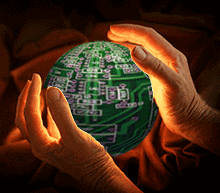 During the 1890’s, inventor Nikola Tesla toyed with the possibility of transferring electricity (safely) through the air. Tesla’s vision has become reality in laboratories within the past decade, and today, the IDG News Service is reporting that Sony has devised a wireless prototype to power its television sets.
During the 1890’s, inventor Nikola Tesla toyed with the possibility of transferring electricity (safely) through the air. Tesla’s vision has become reality in laboratories within the past decade, and today, the IDG News Service is reporting that Sony has devised a wireless prototype to power its television sets.
The technology, called magnetic resonance, achieves power transfer by feeding energy from a power supply into a coil of wires to produce a magnetic field. A current is transferred when a secondary cool falls within that field. Sony used the technique to send 100 volts of electricity 50 centimeters to “plug in” a wireless 22-inch television set.
Other metallic devices that fall within the field will not become significantly electrified, according to the company. The range can be extended to 80 cm with passive relay units, according to IDG.
Sony’s power system is hardly unique. In 2007, a team of MIT researchers was able to power a light bulb from as far as 7 feet away by using magnetic resonance. But there was considerable energy loss with only 40 percent efficiency.
The research was spun off into company called WiTricity, and it is planning a commercial rollout of the technology – once it is refined. If Sony’s experiment is any indication, those refinements could take awhile.
Sony is also tackling the efficiency issue. While its prototype was 80 percent efficient, additional energy loss occurred after the transmission was made to the secondary coil. One quarter of the original 80 watts was lost.
With further improvements, the energy loss could become more acceptable, but I don’t believe in wasting electricity (and potentially increasing carbon emissions) for aesthetics. If the technology could be used to eliminate the need for toxic batteries to power portable devices, Sony could be onto something. For now, though, a power cord does the job just fine for televisions.

 Way back in August of 1999–hey, that was a decade ago, in a different century!–I was lucky enough to visit
Way back in August of 1999–hey, that was a decade ago, in a different century!–I was lucky enough to visit  Imagine that you could charge a car battery as quickly as you fill up a tank of gasoline today. Stop imagining –it has become possible. Researchers have
Imagine that you could charge a car battery as quickly as you fill up a tank of gasoline today. Stop imagining –it has become possible. Researchers have